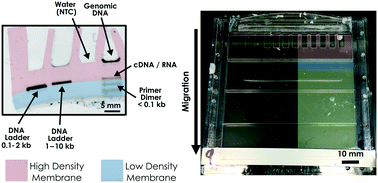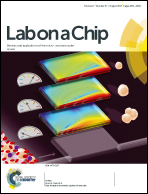Gel-seq: whole-genome and transcriptome sequencing by simultaneous low-input DNA and RNA library preparation using semi-permeable hydrogel barriers†
Abstract
The advent of next generation sequencing has fundamentally changed genomics research. Unfortunately, standard protocols for sequencing the genome and the transcriptome are incompatible. This forces researchers to choose between examining either the DNA or the RNA for a particular sample. Here we describe a new device and method, collectively dubbed Gel-seq, that enables researchers to simultaneously sequence both DNA and RNA from the same sample. This technology makes it possible to directly examine the ways that changes in the genome impact the transcriptome in as few as 100 cells. The heart of the Gel-seq protocol is the physical separation of DNA from RNA. This separation is achieved electrophoretically using a newly designed device that contains several different polyacrylamide membranes. Here we report on the development and validation of this device. We present both the manufacturing protocol for the device and the biological protocol for preparing genetic libraries. Using cell lines with uniform expression (PC3 and Hela), we show that the libraries generated with Gel-seq are similar to those developed using standard methods for either RNA or DNA. Furthermore, we demonstrate the power of Gel-seq by generating a matched genome and transcriptome library from a sample of 100 cells collected from a mouse liver tumor.



 Please wait while we load your content...
Please wait while we load your content...